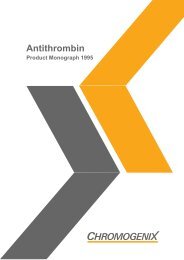Plasminogen - Chromogenix
Plasminogen - Chromogenix
Plasminogen - Chromogenix
Create successful ePaper yourself
Turn your PDF publications into a flip-book with our unique Google optimized e-Paper software.
<strong>Plasminogen</strong>, version 1.1<br />
Introduction<br />
Chromogenic Substrate Assays for <strong>Plasminogen</strong> and<br />
their Diagnostic Relevance<br />
<strong>Plasminogen</strong> is the inactive precursor of plasmin, a potent serine protease involved in<br />
the dissolution of fibrin blood clots. Both hereditary and acquired forms of<br />
plasminogen deficiency have been described. These are usually associated with either a<br />
thrombotic or a hyperfibrinolytic condition. In this monograph we review the<br />
plasminogen-plasmin system and describe two chromogenic-based assay kits for the<br />
photometric determination of plasminogen activity in human plasma.<br />
Blood coagulation is a complex enzymatic event<br />
culminating in the formation of an insoluble threadlike<br />
protein called fibrin. Together with platelets,<br />
fibrin forms a hemostatic plug to prevent excessive<br />
bleeding. Fibrin blood clots are ultimately dissolved<br />
in due course in order to restore vascular patency.<br />
The enzymes involved in this physiologically<br />
important process are part of the fibrinolytic system<br />
(Figure 1). 1-2<br />
The central component in the fibrinolytic system<br />
is the glycoprotein plasminogen, which is produced<br />
by the liver and is present in plasma and most<br />
extravascular fluids. <strong>Plasminogen</strong> is a precursor<br />
enzyme (zymogen) which, following partial cleavage<br />
by a plasminogen activator is converted to its<br />
active and proteolytic form, plasmin. Its primary<br />
target is fibrin, but it is also able to degrade several<br />
constituents of the extracellular matrix and to convert<br />
a number of pro-hormones and cytokine precursors<br />
to their active form. Plasmin also appears to be<br />
involved in the metastatic spread of cancer.<br />
The generation of plasmin occurs preferentially<br />
on the fibrin surface, which offers binding sites for<br />
plasminogen and its principle activator in blood, t-PA.<br />
This binding stimulates plasminogen activation, but<br />
also localizes the action of plasmin to sites of fibrin<br />
formation which promotes efficient clot lysis.<br />
Further regulation is provided by the presence in<br />
plasma of inhibitors, primarily the plasmin inhibitor<br />
and the plasminogen activator inhibitor 1 (PAI-1).<br />
3<br />
PAI-1<br />
<strong>Plasminogen</strong><br />
u-PA<br />
t-PA<br />
Figure 1. The fibrinolytic system<br />
Plasmin<br />
Plasmin inhibitor<br />
Fibrin<br />
FDP<br />
The important role of plasminogen in fibrinolyis<br />
makes it an interesting parameter to evaluate in<br />
various diseases. A decreased plasminogen level<br />
may in some situations compromise the body's<br />
ability to degrade fibrin and as such predispose to<br />
thrombosis. Hereditary plasminogen deficiency, as a<br />
cause of thrombosis, have also been reported in<br />
several cases. 5-7 However, plasminogen deficiency is<br />
usually an acquired condition and since plasminogen<br />
is the inactive precursor of plasmin, most acquired<br />
defects are found in situations with increased fibrinolytic<br />
activity. An acquired deficiency is often seen<br />
with severe liver disease and acute disseminated<br />
intravascular coagulation (DIC), or as a result of<br />
thrombolytic therapy with plasminogen activators. 3,4



